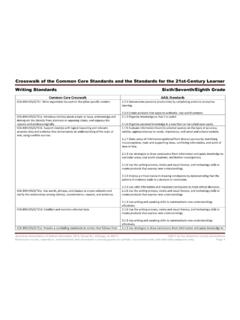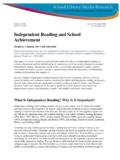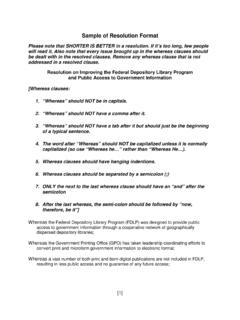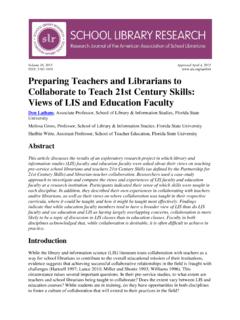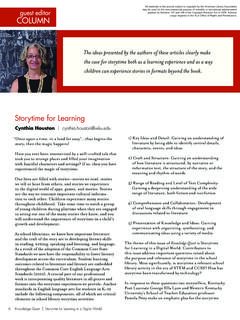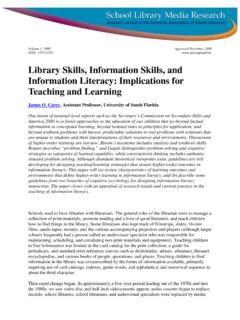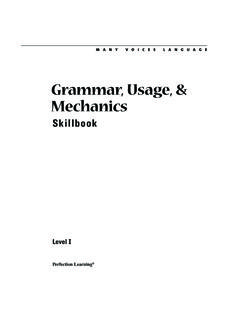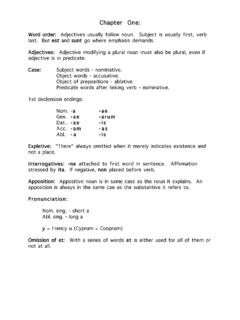Transcription of Crosswalk of the Common Core Standards and the Standards ...
1 Crosswalk of the Common Core Standards and the Standards for the 21st-Century Learner English Language Arts Kindergarten Common Core Crosswalk AASL Standards Conventions of Standard English: Demonstrate command of the conventions of standard English grammar and usage when writing or speaking. Conventions of Standard English: Print many upper- and lowercase letters. Conventions of Standard English: Use frequently occurring nouns and verbs. Conventions of Standard English: Form regular plural nouns orally by adding /s/ or /es/ ( , dog, dogs; wish, wishes).
2 Conventions of Standard English: Understand and use question words Develop and refine a range of questions to frame search for new (interrogatives) ( , who, what, where, when, why, how). understanding. Conventions of Standard English: Use the most frequently occurring prepositions ( , to, from, in, out, on, off, for, of, by, with). Conventions of Standard English: Produce and expand complete sentences in shared language activities. Conventions of Standard English: Demonstrate command of the conventions of standard English capitalization, punctuation, and spelling when writing.
3 Conventions of Standard English: Capitalize the first word in a sentence and the pronoun I. Conventions of Standard English: Recognize and name end punctuation. Conventions of Standard English: Write a letter or letters for most consonant and short-vowel sounds (phonemes). Conventions of Standard English: Spell simple words phonetically, drawing on knowledge of sound-letter relationships. Vocabulary Acquisition and Use: Determine or clarify the meaning of Use prior and background knowledge as context for new learning.
4 Unknown and multiple-meaning words and phrases based on kindergarten reading and content. Vocabulary Acquisition and Use: Identify new meanings for familiar words and apply them accurately ( , knowing duck is a bird and learning the verb to duck). Vocabulary Acquisition and Use: Use the most frequently occurring inflections and affixes ( , -ed, -s, re-, un-, pre-, -ful, -less) as a clue to the meaning of an unknown word. American Association of School Librarians, 50 E. Huron St., Chicago, IL 60611 2011 by the American Library Association Permission to use, reproduce, and distribute this document is hereby grants for private, non-commercial, and education purposes only.
5 Page 1. Vocabulary Acquisition and Use: With guidance and support from adults, explore word relationships and nuances in word meanings. Vocabulary Acquisition and Use: Sort Common objects into categories ( , shapes, foods) to gain a sense of the concepts the categories represent. Vocabulary Acquisition and Use: Demonstrate understanding of frequently occurring verbs and adjectives by relating them to their opposites (antonyms). Vocabulary Acquisition and Use: Identify real-life connections between words and their use ( , note places at school that are colorful).
6 Vocabulary Acquisition and Use: Distinguish shades of meaning among verbs describing the same general action ( , walk, march, strut, prance) by acting out the meanings. Vocabulary Acquisition and Use: Use words and phrases acquired through conversations, reading and being read to, and responding to texts. Print Concepts: Demonstrate understanding of the organization and basic features of print. Print Concepts: Follow words from left to right, top to bottom, and page by page. Print Concepts: Recognize that spoken words are represented in written language by specific sequences of letters.
7 Print Concepts: Understand that words are separated by spaces in print. Print Concepts: Recognize and name all upper- and lowercase letters of the alphabet. Phonological Awareness: Demonstrate understanding of spoken words, syllables, and sounds (phonemes). Phonological Awareness: Recognize and produce rhyming words. Phonological Awareness: Count, pronounce, blend, and segment syllables in spoken words. Phonological Awareness: Blend and segment onsets and rimes of single-syllable spoken words. Phonological Awareness: d.
8 Isolate and pronounce the initial, medial vowel, and final sounds (phonemes) in three-phoneme (consonant-vowel- consonant, or CVC) words.*(This does not include CVCs ending with /l/, /r/, or /x/.). Phonological Awareness: Add or substitute individual sounds (phonemes) in simple, one-syllable words to make new words. Phonics and Word Recognition: Know and apply grade-level phonics and word analysis skills in decoding words. American Association of School Librarians, 50 E. Huron St., Chicago, IL 60611 2011 by the American Library Association Permission to use, reproduce, and distribute this document is hereby grants for private, non-commercial, and education purposes only.
9 2. Phonics and Word Recognition: Demonstrate basic knowledge of letter-sound correspondences by producing the primary or most frequent sound for each consonant. Phonics and Word Recognition: Associate the long and short sounds with the Common spellings (graphemes) for the five major vowels. Phonics and Word Recognition: Read Common high-frequency words by sight. ( , the, of, to, you, she, my, is, are, do, does). Phonics and Word Recognition: Distinguish between similarly spelled words by identifying the sounds of the letters that differ.
10 Read emergent-reader texts with purpose and understanding. Read, view, and listen for information presented in any format ( , textual, visual, media, digital) in order to make inferences and gather meaning. Key Ideas and Details: With prompting and support, ask and answer Read, view, and listen for information presented in any format ( , textual, questions about key details in a text. visual, media, digital) in order to make inferences and gather meaning. Key Ideas and Details: With prompting and support, identify the main Read, view, and listen for information presented in any format ( , textual, topic and retell key details of a text.)
